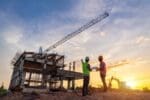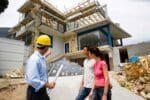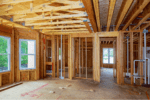Note: Distinguished Programs no longer offers Builder’s Risk or Vacant Building insurance through our City Insurance division. Explore our other programs for tailored solutions.
As extreme weather events increase and contractors continue to build along the coast, Coastal Builder’s Risk insurance is critical to protect the investment. In this article, we explore the importance of Coastal Builder’s Risk insurance and how it can help.
Sun, sea, and surf: America’s coastlines are chock-full of beautiful vistas and idyllic places to live and retire in. However, when it comes to insuring construction at one of these coastal locations, the experience can be a bit of a nightmare.
Most insurance companies will not offer builder’s risk insurance in high-risk areas near the coast. That means it can be difficult to find fair policies that balance competitive premiums, comprehensive coverage, and proper risk assessment in places like Georgia, the Carolinas, or other coastal states.
Luckily, Distinguished Programs offers Coastal Builder’s Risk insurance specially designed for these in-demand, high-risk coastal areas. So whether it’s a project overlooking the Atlantic Ocean or the Gulf of Mexico, you can ensure your client’s construction project has the builder’s risk insurance coverage it needs.
What is Coastal Builder’s Risk Insurance?
Coastal Builder’s Risk insurance is a specialized Builder’s Risk program designed around the unique needs of coastal properties.
With this program, clients can insure their under-construction buildings, renovations, or betterment projects throughout the construction process. This way, even if there is an unexpected weather event, like a freak storm, their job site is insured against any potential damages.
What Does Coastal Builder’s Risk Cover?
When you think about Coastal Builder’s Risk insurance coverage, you probably immediately think about the big ticket items, like protection from named storms blowing in during hurricane season.
Of course, it does provide coverage for these kinds of exposures, but Distinguished’s Coastal Builder’s Risk is all risk and can help your clients with:
- Acts of God: This includes storms, fires, and other natural disasters.
- Vandalism: Any destruction of property caused by outside parties.
- Theft: Covers the cost of replacing stolen equipment.
- Property damage: This includes damages to the building or building supplies during construction.
- Damage to on-site structures or off-site property in transit: If on-site structures, like scaffolding, or materials in transit to the site, are damaged by a covered event, then those too would be covered.
- Debris and pollutant removal: The cost of cleaning up debris and pollutants after a covered incident.
- Sewer and drain backup: For damage caused by contaminated water from backed-up sewers or drains.
- Trees and shrubs: Covers damages to any trees or shrubs installed on the property.
- Fungus: Covers costs related to cleanup and disposal of fungus caused by a covered event.
Beyond what exposures are covered, it’s important to note what projects we accept. With Distinguished’s Coastal Builder’s Risk, we work with new construction, remodeling, and betterment projects, including beachfront or barrier island properties.
For more information on what Distinguished’s Coastal Builder’s Risk covers, take a look at our Builder’s Risk product page.
Who Needs Coastal Builder’s Risk Insurance?
Coastal Builder’s Risk insurance is an essential insurance policy not just for beachfront properties but also for construction sites that are near the coast or within a high-risk area. This could include properties in places like Texas, Georgia, Alabama, and other coastal states.
If you find your client doesn’t qualify for typical Builder’s Risk insurance due to the risk of coastal events, then a specialized Coastal Builder’s Risk policy may be needed.
How Much Does Coastal Builder’s Risk Insurance Cost?
Because Coastal Builder’s Risk insurance is so specialized, you’ll need to work directly with a knowledgeable underwriter to get a real estimate of what it might cost. Each property and location has unique exposures and risk levels that will ultimately impact the price of the policy.
Here are just a few factors our underwriters consider when evaluating a coastal property:
- Project type: Is it ground up, new construction, or a remodel?
- Construction material: What materials are being used in the construction, how expensive are they, and do they increase the risk level?
- Location of the project site: How risky is this site, and what are the chances it may get affected by a weather event?
If you have a client that needs to get a builder’s risk insurance quote for their coastal property right away, we can help. Simply register your agency and submit your application online, and one of our experts will get back to you with a quote in 24-48 hours.
Why Is Coastal Builder’s Risk Becoming More Necessary?
As extreme weather events increase and construction near the coasts continues to expand, Coastal Builder’s Risk insurance is quickly becoming an essential form of coverage for those in higher-risk areas.
Here are just a couple of reasons why you may see more Coastal Builder’s Risk clients in the near future.
Extreme Weather Events
Every year it seems like extreme weather events are becoming more common and more costly.
For instance, data from NOAA shows that we are getting, on average, two more named storms and one extra hurricane each year compared to the 80s and 90s. This matters because even one hurricane can cause catastrophic damage. In 2022, Hurricane Ian hit Fort Myers Beach and Naples, causing over $114 billion in damages. This made Ian the third most expensive hurricane in American history behind Harvey (2017) and Katrina (2005).
The severity of these and other disasters has shown that the potential for damage to construction projects is all too real. However, with Coastal Builder’s Risk insurance, construction sites can at least know they’re financially covered should the worst happen.
People Keep Moving To High-Risk Areas
More people are moving to areas where climate impacts are more likely to occur. According to real estate company Redfin, from 2016 to 2020, more people moved to high-risk areas like Texas, Arizona, and Nevada than to low-risk areas.
For this reason, insurance companies are having to pay out more claims as the number and severity of natural disasters increase. Many insurers have already pulled out of high-risk areas, such as Florida and Louisiana, making it more difficult and expensive for residents and businesses to get coverage. However, this isn’t preventing people from building and moving to these areas.
Therefore, those opting to live in coastal areas must take measures to reduce their property risks. In addition, they need to purchase insurance and the right type of coverage. Having the right coverage applies to existing buildings and structures, properties under construction, and those undergoing remodeling, with both of the latter needing builder’s risk.
Where is Coastal Builder’s Risk Most Important?
Coastal Builder’s Risk is most important in states affected by hurricane season. Here are five states where your clients may require a specialized Coastal Builder’s Risk policy.
- New Jersey: Prone to storm damage due to its location along the Atlantic Coast, where it can get hit by both tropical storms and powerful Nor’easters.
- South Carolina: South Carolina’s low-lying coastal areas are prone to storm surges, which can further increase damage even in locations off the immediate coastline.
- North Carolina: One of the most hurricane-hit states, only falling behind Florida, Texas, and Louisiana.
- Georgia: Located just above Florida, Georgia is usually ground zero for many major storms that come in from either the Atlantic or the Gulf.
- Alabama: Primarily at risk because of its coastline on the Gulf of Mexico.
Coastal Builder’s Risk Insurance Available At Distinguished
Distinguished offers our Coastal Builder’s Risk program for residential (single-family homes and multi-family units) and light commercial properties under construction in the coastal areas of the following states:
- Alabama
- Delaware
- Georgia
- Maryland
- Mississippi
- New Jersey
- North Carolina
- Rhode Island
- South Carolina
- Virginia
- Texas (commercial-only properties)
Backed by an A-rated carrier, coverage is available for new construction, remodels, and betterments-only projects. The program provides coverage for all risks and includes theft and vandalism insurance. Several additional coverages are available as well—from debris removal to sewer and drain backup.
Using our broker portal, you can submit, quote, and bind coverage for our Coastal Builder’s Risk program online.
If you have other questions, you can:
- Contact one of our insurance experts
- Read our article on Builder’s Risk Insurance basics
- Check out our Builder’s Risk Q&A
- Read the FAQs below
Coastal Builder’s Risk FAQs
What states are eligible for this program?
Coastal Builder’s Risk is available in Alabama, Delaware, Georgia, Hawaii, Maryland, Mississippi, North Carolina, South Carolina, Rhode Island, and Virginia. In Texas, we only insure light commercial properties.
What are the eligible project types?
We insure new construction, remodeler’s, and betterments-only projects.
What is your TIV?
- New Construction – TIV up to $20M (Frame brand new construction up to $6.5M TIV)
- Remodeler’s Risks – TIV up to $5M
- Betterments Only – TIV up to $5M
Who is Distinguished’s carrier partner for this insurance?
Our Coastal Builder’s Risk coverage is provided by Palomar and is on A rated paper.






